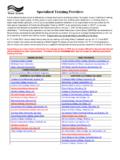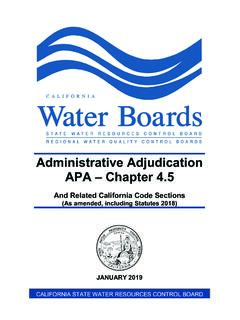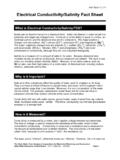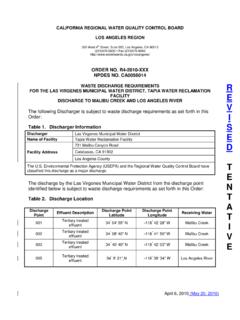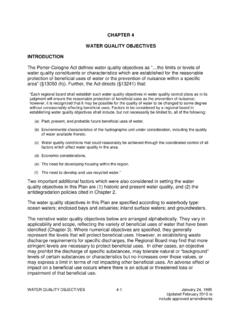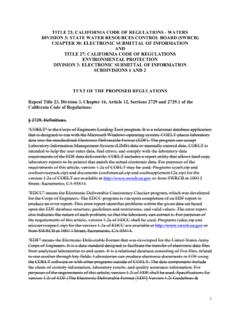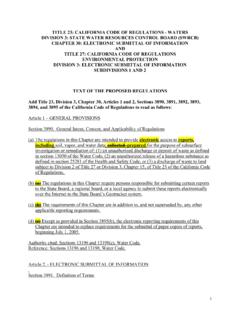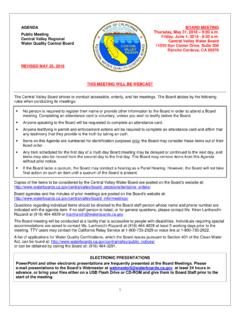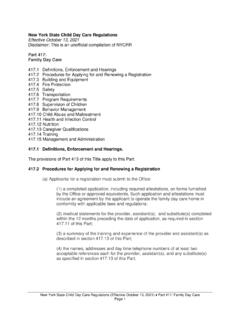Transcription of Calculating Geometric Means - California
1 Calculating Geometric Means by Dr. Joe Costa, Buzzards Bay National Estuary Program Definition of Geometric Mean Mathematical definition: The n-th root of the product of n numbers. Practical definition: The average of the logarithmic values of a data set, converted back to a base 10 number. Geometric Means for Water Quality Standards Many wastewater dischargers, as well as regulators who monitor swimming beaches and shellfish areas, must test for and report fecal coliform bacteria concentrations. Often, the data must be summarized as a " Geometric mean" (a type of average) of all the test results obtained during a reporting period. Typically, public health regulations identify a precise Geometric mean concentration at which shellfish beds or swimming beaches must be closed. A Geometric mean, unlike an arithmetic mean, tends to dampen the effect of very high or low values, which might bias the mean if a straight average (arithmetic mean) were calculated.
2 This is helpful when analyzing bacteria concentrations, because levels may vary anywhere from 10 to 10,000 fold over a given period. As explained below, Geometric mean is really a log-transformation of data to enable meaningful statistical evaluations. Other Uses of Geometric Means Besides being used by scientists and biologists, Geometric Means are also used in many other fields, most notably financial reporting. This is because when evaluating investment returns and fluctuating interest rates, it is the Geometric mean, not the arithmetic mean, that tells you what the average financial rate of return would have had to have been over the entire investment period to achieve the end result. Financial Return Calculation For financial investment return calculations, the Geometric mean is calculated on the decimal multiplier equivalent values, not percent values ( , a 6% increase becomes ; a 3% decline is transformed to Just follow the steps outlined in the section below titled Calculating Geometric Means with Negative Values).
3 The equation is also flipped around when Calculating the financial rate of return if you know the starting value, end value, and the time period. This equation is used in these cases when the average rate of return is needed (or population growth rate): Note: If you subtract 1 from the equation above, this is your compound interest rate. To use this equation, if years=5, this is the "fifth root", which is the same as raising to the power of 1/5 or ). Problem submitted by a student: "A recent article suggested that if you earn $25,000 a year today and the inflation rate continues at 3 percent per year, you'll need to make $33,598 in 10 years to have the same buying power.. Confirm that this statement is accurate by finding the Geometric mean rate of increase" Solution using a formula in Excel: =Power(33598/25000,.1)= When to Use or Not Use Geometric Mean Geometric mean is often used to evaluate data covering several orders of magnitude, and sometimes for evaluating ratios, percentages, or other data sets bounded by zero.
4 If your data covers a narrow range (I have seen it stated that the largest value must be at least 3x the smallest value), or if the data is normally distributed around high values ( skew to the left), Geometric Means and log transformations may not be appropriate. Do not use Geometric mean on data that is already log transformed such as pH or decibels (dB). Geometric Mean Calculation How do you calculate a Geometric mean? The easiest way to think of the Geometric mean is that it is the average of the logarithmic values, converted back to a base 10 number. However, the actual formula and definition of the Geometric mean is that it is the n-th root of the product of n numbers, or: Geometric Mean = n-th root of (X1)(X2)..(Xn) Where X1, X2, etc. represent the individual data points, and n is the total number of data points used in the calculation.
5 If this is the definition of Geometric mean, why is my first statement true, that Geometric mean is really the average of the log values? Consider this example. Suppose you wanted to calculate the Geometric mean of the numbers 2 and 32. This simple example can be done in your head. First, take the product; 2 times 32 is 64. Because there are only two numbers, the n-th root is the square root, and the square root of 64 is 8. Therefore the Geometric mean of 2 and 32 is 8. Now, let's solve the problems using logs. In this case, we will convert to base-2 logs so that we can solve the problem in our head (in fact, any base could be used). Converting our numbers, we have: 2=21 32=25 21 x 25 = 26 (=64) the square root of 26 is 23 (=8) Of course, the short cut to solve the problem is to take the average of the two exponents (1 and 5) which is 3, and 23 is 8.
6 Problem: Can you calculate the Geometric mean of these 5 numbers, in your head? 23, 25, 28, 23, 21 (These values of course equal 8, 32, 256, 8, and 2) (Hint: The 5 exponents add up to 20.) Click for the answer. From the discussion above, you can see that the calculation of the Geometric Mean can be performed by either of two procedures on a calculator, depending upon which functions are available. Computer-based spreadsheet programs like Excel have built Geometric mean functions, and in general you should use these (see below) to save time if a computer with the appropriate software is available. Calculation Procedure 1: Multiply all of the data points, and take the n-th root of this product. Example: Suppose you have this beach monitoring data from different dates: (data are Enterococci bacteria per 100 milliliters of sample) 6 ml 50 ml 9 ml 1200 ml Geometric Mean = 4th root of (6)(50)(9)(1200) = 4th root of 3,240,000 Geometric Mean = ml On a good scientific calculator, you would multiply the numbers together, press equal, then the root key, then the number 4 to get the forth root (or enter with the exponent key on the last part).
7 Calculation Procedure 2: Take the average of the logs, then convert to a base 10 number Of course, many calculators do not have a root key that allow the calculation of any root, so you must use the logarithm function, which is typically more widely available on calculators. To use this calculation procedure, you must have a calculator which will give logarithms (log or ln) and anti-logarithms (exp or e). The first step in Calculating the Geometric Mean using this method is to determine the logarithm of each data point using your calculator. Next, add all of the data point logarithms together and divide this sum by the number of data points (n). In other words, take the average of the logs. Next, convert this log average back to a base 10 number using the antilogarithm function key on the calculator. Example (using previous data): log 6= log 50= log 9= log 1200= Sum= The logarithm of the Geometric Mean is = (the average of the logs) From your calculator, determine the number whose logarithm is (use the antilogarithm key), and you will find that the Geometric Mean = ml This process works whether or not you use natural logs ("ln" key) or base 10 logs ("log" key).
8 That is, on your calculator you could do ln(x1), ln(x2), etc. then use the 'ex' key on the average of the logs, or you would do log(x1), log(x2), etc. then use the '10x' key on the average of the logs. (key names may vary among calculators). Incidentally, for this example data set, the arithmetic mean (average) of the four data points is: Arithmetic Mean = (6 + 50 + 9 + 1200)/4 = 1265/4 Arithmetic Mean = colonies/100 ml The Geometric mean is always less than the arithmetic mean (except of course if all the data points have an identical value). On most scientific calculators your key sequences to calculate the Geometric mean would be: enter a data point, press either the Log or ln function key, record the result or store it in memory, calculate the mean or average of these log values, calculate the antilog value of this mean ('10x' key if you used 'Log' key, 'ex' key if you used 'ln' key) Excel #Num!
9 Overflow error In Excel and Quattro an error may be obtained in the Geometric mean function if you apply the function to a very long list of numbers. This occurs because of a numeric overflow error (the product of the numbers is so large the software cannot compute them the way the software is written). If this occurs, you can use an "array formula." An array formula is one that repeats the same calculations over an array (list) of numbers. This "average of the logs" formula will work fine in such situations: {=EXP(AVERAGE(LN(A1:A200)))} Do not enter the curly brackets. Enter the formula "=EXP( ", then create the array formula by pressing Control+Shift+Enter simultaneously on your keyboard while your cursor is inside the formula cell. Change A1 and A2 to the actual locations of the first and last values of the data set. Calculating Geometric Means in Spreadsheets Rather than using a calculator, it is far easier to use spreadsheet functions.)
10 For example, in Microsoft Excel the simple function "GeoMean" is provided to calculate the Geometric mean of a series of data. For example, if you had 11 values in the range , you would simply write this formula in any empty cell: '=geomean(A1:A10)'. In Corel Quattro spreadsheets, the function is In both programs, you can enter values directly inside the parentheses (x1,x2,x3) instead of referencing a range of cells. Calculating Geometric Means with Zero Values The calculation of the Geometric Mean may appear impossible if one or more of the data points is zero (0). In these cases, however, the convention used is that a value of either '1', one half the limit of detection, or some other substitution is allowed for each zero or "less than" value, so that the information contained in these data is not lost. For example, the US Food and Drug Administration in its shellfish sanitation program regulations requires the substitution of a value that is one significant digit less than the detection limit [ "less than 2" becomes " "].
